Write a C program to implement the Binary Tree operations and display its traversals.
Outline of a Binary Search Tree:
- What is a Tree?
- What is a Binary Tree?
- Doubly Linked List Representation of a Binary Tree Node
- Implementation of Binary Tree (Program/Code)
- Binary Tree – insert() Method
- Binary Tree – delete() Method
- Binary Tree – search() Method
- Traversals of the Binary Tree
A tree is a non-linear data structure in which the data is stored non-linearly. A tree is used to represent the data in hierarchical form.
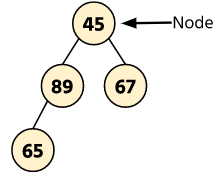
The above image represents a tree in which four nodes are connected in a hierarchical structure. Every node contains some integer data and the address of its children.
A binary tree is a kind of tree in which every node contains at most two children. A node contains the address of the left and right child in the linked list representation of the binary tree.
If a node does not contain either child, its field will be NULL. If there are no children for that node then it is called the Leaf node.
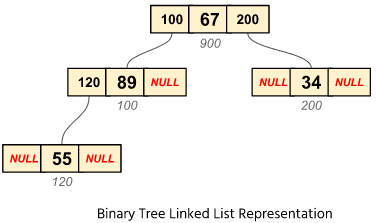
We will implement the binary tree using the doubly linked list. A doubly linked list contains the address of the left and right children and the data of the node. The left pointer of the node points to the left children and the right pointer points to the right children.
Here is the representation of a node using a doubly linked list.
struct node { int data; struct node* left; struct node* right; };
Doubly Linked List representation of a Binary Tree node:
| left* | data | right* |
Here is the source code of the C program to implement the Binary Tree. The C program is successfully compiled and run on a Linux system. The program output is also shown below.
/** C Program to Implement the Binary Tree*/#include<stdio.h>#include<stdlib.h>#define MAX_SIZE 25#define max(a, b) a>b ? a : bstruct TreeNode{int val;
struct TreeNode* left;
struct TreeNode* right;
};
// global root declarationstruct TreeNode* root = NULL;
// function prototypingvoid insert(int);
void delete(int);
int search(int);
int height(struct TreeNode*);
void inorder(struct TreeNode*);
void preorder(struct TreeNode*);
void postorder(struct TreeNode*);
void levelorder();
int main()
{int user_choice, node_data;
char user_active = 'Y';
while(user_active == 'Y' || user_active == 'y')
{printf("\n\n--- Binary Tree --\n\n");
printf("\n1. Insert ");
printf("\n2. Delete");
printf("\n3. Search");
printf("\n4. Height");
printf("\n5. Inorder Traversal");
printf("\n6. Preorder Traversal");
printf("\n7. Postorder Traversal");
printf("\n8. Level order Traversal");
printf("\n9. Exit");
printf("\n\nEnter Your Choice: ");
scanf("%d", &user_choice);
printf("\n");
switch(user_choice)
{case 1:
printf("Enter data for new node: ");
scanf("%d", &node_data);
insert(node_data);
break;
case 2:
printf("Enter node data: ");
scanf("%d", &node_data);
delete(node_data);
break;
case 3:
printf("Enter node data: ");
scanf("%d", &node_data);
int has_found = search(node_data);
if(has_found == -1) {
printf("\nNode was not found!");
} else {
printf("\nNode was found");
}break;
case 4:
printf("height of the tree is: %d", height(root));
break;
case 5:
printf("Inorder Traversal\n\n");
inorder(root);
break;
case 6:
printf("Preorder Traversal\n\n");
preorder(root);
break;
case 7:
printf("Postorder Traversal\n\n");
postorder(root);
break;
case 8:
printf("Level order Traversal\n\n");
levelorder();
break;
case 9:
printf("Program is terminating...\n\n");
exit(0);
default:
printf("Invalid choice");
}fflush(stdin);
printf("\n\n\nDo you want to continue? (Y/N) ");
scanf("%c", &user_active);
}return 0;
}struct TreeNode* create(int data)
{struct TreeNode* new_node = (struct TreeNode*) malloc (sizeof(struct TreeNode));
if(new_node == NULL)
{printf("\nMemory can't be allocated for new node\n");
return NULL;
}new_node->left = NULL;
new_node->right = NULL;
new_node->val = data;
return new_node;
}// inserts a new node in the treevoid insert(int data)
{if(root == NULL)
{struct TreeNode* new_node = create(data);
if(new_node)
{root = new_node;
printf("\n * Node with data %d was inserted", data);
}return;
}struct TreeNode* queue[MAX_SIZE];
struct TreeNode* new_node = NULL;
int front = -1;
int rear = -1;
queue[front+1] = root;
front = rear = 0;
while(front <= rear)
{struct TreeNode* temp = queue[front];
front++;if(temp->left != NULL)
{queue[++rear] = temp->left;
}else{new_node = create(data);
if(new_node)
{temp->left = new_node;
printf("\n* Node with data %d was inserted", data);
}return;
}if(temp->right != NULL)
{queue[++rear] = temp->right;
}else{new_node = create(data);
if(new_node)
{temp->right = new_node;
printf("\n* Node with data %d was inserted", data);
}return;
}}}void delete(int key)
{// Tree is emptyif(root == NULL)
{return;
}// Tree having only one nodeif(root->left == NULL && root->right == NULL)
{if(root->val == key)
{root = NULL;
printf("\n* Node with data %d was deleted", key);
return;
}else{return;
}}// level order traversal using the queuestruct TreeNode* temp = NULL, *last_node = NULL, *key_node = NULL;
struct TreeNode* queue[MAX_SIZE];
int front = -1;
int rear = -1;
queue[front + 1] = root;
front = rear = 0;
// do level order traversal to find the deepest nodewhile (front <= rear)
{temp = queue[front];
front++;if (temp->val == key)
{key_node = temp;
}if (temp->left != NULL)
{last_node = temp;
queue[++rear] = temp->left;
}if (temp->right != NULL)
{last_node = temp;
queue[++rear] = temp->right;
}}// if key is found in the binary treeif (key_node != NULL)
{// replace the keynode data with the deepest nodekey_node->val = temp->val;
// free the last node after updating its parentif (last_node->right == temp)
{last_node->right = NULL;
}else{last_node->left = NULL;
}printf("\n* Node with data %d was deleted", key);
free(temp);
return;
}printf("\n* Node with data %d was not found", key);
}int search(int key)
{if (root == NULL)
{return -1;
}struct TreeNode* queue[MAX_SIZE];
int front = -1;
int rear = -1;
queue[front + 1] = root;
front = rear = 0;
// do level order traversal to find the deepest nodewhile (front <= rear)
{struct TreeNode* temp = queue[front];
front++;if (temp->val == key)
{return 1;
}if (temp->left != NULL)
{queue[++rear] = temp->left;
}if (temp->right != NULL)
{queue[++rear] = temp->right;
}}return -1;
}int height(struct TreeNode* root)
{if (root == NULL)
{return 0;
}int left = height(root->left);
int right = height(root->right);
if(left > right)
{return left + 1;
}else{return right + 1;
}}// inorder traversalvoid inorder(struct TreeNode* root)
{if(root == NULL) return;
inorder(root->left);
printf("%d ", root->val);
inorder(root->right);
}// preorder traversalvoid preorder(struct TreeNode* root)
{if(root == NULL) return;
printf("%d ", root->val);
preorder(root->left);
preorder(root->right);
}// postorder traversalvoid postorder(struct TreeNode* root)
{if(root == NULL) return;
postorder(root->left);
postorder(root->right);
printf("%d ", root->val);
}// level order traversalvoid levelorder()
{if (root == NULL)
{printf("Tree is Empty!");
return;
}struct TreeNode* queue[MAX_SIZE];
int front = -1;
int rear = -1;
queue[front + 1] = root;
front = rear = 0;
// do level order traversal to find the deepest nodewhile (front <= rear)
{struct TreeNode* temp = queue[front];
front++;printf("%d ", temp->val);
if (temp->left != NULL)
{queue[++rear] = temp->left;
}if (temp->right != NULL)
{queue[++rear] = temp->right;
}}}
Here we have discussed the main functions of the Binary Tree with time and space complexities.
Insertion is the method to add a new node in the Binary Tree. We are traversing the binary tree in level order so that we can balance the binary tree on insertion at each level.
- Start traversing the tree from the root node in level order.
- Insert the node at the left children of a node, If the left child of a node is NULL.
- If the left child is not NULL then check for the right child, Insert the node at the right of the node.
- Exit.
Example: Let’s insert the given nodes in the Binary Tree.
Nodes = [89, 56, 45, 2, 55]
Step 1: Insert a new node 89.

Step 2: Insert a new node 56.
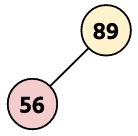
Step 3: Insert a new node 45.
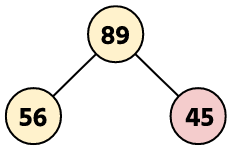
Step 4: Insert a new node 2.
Step 5: Insert a new node 55.
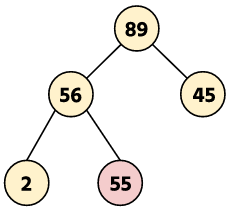
Time Complexity: O(n)
We need to traverse each node in level order to find the right position to insert the new node in a binary tree.
Space Complexity: O(n)
Since we are using the queue to store the tree nodes.
In this case, we are inserting the nodes in binary tree.
--- Binary Tree -- 1. Insert 2. Delete 3. Search 4. Height 5. Inorder Traversal 6. Preorder Traversal 7. Postorder Traversal 8. Level order Traversal 9. Exit Enter Your Choice: 1 Enter data for new node: 89 * Node with data 89 was inserted Do you want to continue? (Y/N) y --- Binary Tree -- 1. Insert 2. Delete 3. Search 4. Height 5. Inorder Traversal 6. Preorder Traversal 7. Postorder Traversal 8. Level order Traversal 9. Exit Enter Your Choice: 1 Enter data for new node: 56 * Node with data 56 was inserted Do you want to continue? (Y/N) y --- Binary Tree -- 1. Insert 2. Delete 3. Search 4. Height 5. Inorder Traversal 6. Preorder Traversal 7. Postorder Traversal 8. Level order Traversal 9. Exit Enter Your Choice: 1 Enter data for new node: 45 * Node with data 45 was inserted Do you want to continue? (Y/N) y --- Binary Tree -- 1. Insert 2. Delete 3. Search 4. Height 5. Inorder Traversal 6. Preorder Traversal 7. Postorder Traversal 8. Level order Traversal 9. Exit Enter Your Choice: 1 Enter data for new node: 2 * Node with data 2 was inserted Do you want to continue? (Y/N) y --- Binary Tree -- 1. Insert 2. Delete 3. Search 4. Height 5. Inorder Traversal 6. Preorder Traversal 7. Postorder Traversal 8. Level order Traversal 9. Exit Enter Your Choice: 1 Enter data for new node: 55 * Node with data 55 was inserted Do you want to continue? (Y/N) n
To delete the node from the tree requires following the given steps:
- Traverse the tree to find the node which has the given key.
- Traverse to find the deepest node.
- Update the data of the key node to the deepest node and then delete the deepest node.
Example: Delete node 34 in the given tree.
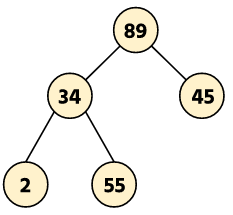
The deepest leftmost node is 55. So replace the deepest node value with the key node.
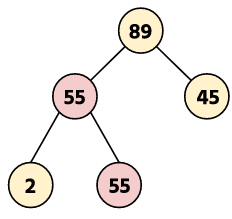
Now delete the deepest node.
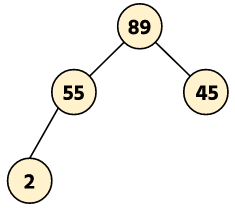
Time Complexity: O(n)
To delete the deepest node we have to traverse the entire tree of size n, where n is the number of nodes in the tree.
Space Complexity: O(n)
Since we are using the queue for the level order traversal. In the worst case, the space depends on the number of nodes in the tree, which is n.
In this case, we are deleting the nodes in binary tree.
Note: The data in the Binary Tree are {89 56 45 2 55}
--- Binary Tree -- 1. Insert 2. Delete 3. Search 4. Height 5. Inorder Traversal 6. Preorder Traversal 7. Postorder Traversal 8. Level order Traversal 9. Exit Enter Your Choice: 8 Level order Traversal 89 56 45 2 55 Do you want to continue? (Y/N) y --- Binary Tree -- 1. Insert 2. Delete 3. Search 4. Height 5. Inorder Traversal 6. Preorder Traversal 7. Postorder Traversal 8. Level order Traversal 9. Exit Enter Your Choice: 2 Enter node data: 56 * Node with data 56 was deleted Do you want to continue? (Y/N) y --- Binary Tree -- 1. Insert 2. Delete 3. Search 4. Height 5. Inorder Traversal 6. Preorder Traversal 7. Postorder Traversal 8. Level order Traversal 9. Exit Enter Your Choice: 8 Level order Traversal 89 55 45 2 Do you want to continue? (Y/N) n
To search a node with the given key we use the level order traversal. Searching a node in a Binary tree needs to follow the given steps:
- Compare the key with each node value and if found the key then return 1 else return -1.
Example: Let’s find the node with data 15 in the given Binary Tree.
Push the root node into the stack and compare it with the key.
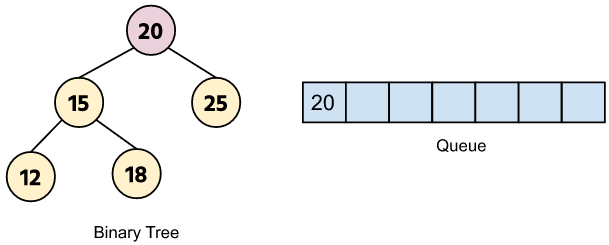
Since, 20 is not equal to 15 so we will push its children and check the data for the other nodes.
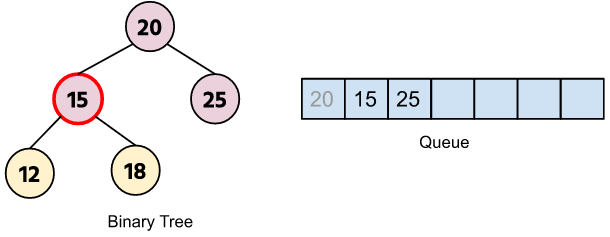
The data of the left child of the root node is equal to the key so we have found the key then return 1.
Time Complexity: O(n)
In the worst case, we have to traverse each node. Here n is the number of nodes in the binary tree.
Space Complexity: O(n)
We are storing the nodes in the queue so in the worst case it takes the linear amount of space.
In this case, we are searching the nodes in binary tree.
Note: The data in the Binary Tree are {89 56 45 2 55}
--- Binary Tree -- 1. Insert 2. Delete 3. Search 4. Height 5. Inorder Traversal 6. Preorder Traversal 7. Postorder Traversal 8. Level order Traversal 9. Exit Enter Your Choice: 8 Level order Traversal 89 56 45 2 55 Do you want to continue? (Y/N) y --- Binary Tree -- 1. Insert 2. Delete 3. Search 4. Height 5. Inorder Traversal 6. Preorder Traversal 7. Postorder Traversal 8. Level order Traversal 9. Exit Enter Your Choice: 3 Enter node data: 89 Node was found Do you want to continue? (Y/N) y --- Binary Tree -- 1. Insert 2. Delete 3. Search 4. Height 5. Inorder Traversal 6. Preorder Traversal 7. Postorder Traversal 8. Level order Traversal 9. Exit Enter Your Choice: 3 Enter node data: 89 Node not found Do you want to continue? (Y/N) n
In inorder traversal, we have to traverse in the following order:
- Traverse to the left to a given node.
- print the node data.
- Traverse to the right to a given node.
Example: Inorder traversal of the tree is given below.
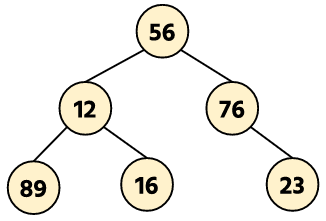
Inorder traversal of the tree: 89, 12, 16, 56, 76, 23
Time Complexity: O(n)
The time complexity of the inorder traversal of a binary tree is O(n). Here, n is the number of nodes. We have to traverse each node in the Binary tree.
Space Complexity: O(h)
The space complexity of the inorder traversal of a binary tree is O(h). Function calling stack requires space of stack.
In this case, we perform an in-order traversal of the binary tree.
Note: The data in the Binary Tree are {89 56 45 2 55}
--- Binary Tree -- 1. Insert 2. Delete 3. Search 4. Height 5. Inorder Traversal 6. Preorder Traversal 7. Postorder Traversal 8. Level order Traversal 9. Exit Enter Your Choice: 5 Inorder Traversal 2 56 55 89 45 Do you want to continue? (Y/N) n
In preorder traversal, we have to traverse in the following order:
- Print the node data.
- Traverse to the left to a given node.
- Traverse to the right to a given node.
Example: Preorder traversal of the binary tree is given below.

Preorder traversal of the tree: 89, 56, 2, 55, 45
Time Complexity: O(n)
The time complexity of the preorder traversal of a binary tree is O(n). Here, n is the number of nodes. We have to traverse each node in the Binary tree.
Space Complexity: O(h)
The space complexity of the preorder traversal of a binary tree is O(h). Function calling stack requires space of stack.
In this case, we perform an preorder traversal of the binary tree.
Note: The data in the Binary Tree are {89 56 45 2 55}
--- Binary Tree -- 1. Insert 2. Delete 3. Search 4. Height 5. Inorder Traversal 6. Preorder Traversal 7. Postorder Traversal 8. Level order Traversal 9. Exit Enter Your Choice: 6 Preorder Traversal 89 56 2 55 45 Do you want to continue? (Y/N) n
In preorder traversal, we have to traverse in the following order:
- Traverse to the left to a given node.
- Traverse to the right to a given node.
- Print the data of the node.
Example: Postorder traversal of the binary tree is given below.

Postorder traversal of the tree: 2, 55, 56, 45, 89
Time Complexity: O(n)
The time complexity of the postorder traversal of a binary tree is O(n). Here, n is the number of nodes. We have to traverse each node in the Binary tree.
Space Complexity: O(h)
The space complexity of the postorder traversal of a binary tree is O(h). Function calling stack requires space of stack.
In this case, we perform an postorder traversal of the binary tree.
Note: The data in the Binary Tree are {89 56 45 2 55}
--- Binary Tree -- 1. Insert 2. Delete 3. Search 4. Height 5. Inorder Traversal 6. Preorder Traversal 7. Postorder Traversal 8. Level order Traversal 9. Exit Enter Your Choice: 7 Postorder Traversal 2 55 56 45 89 Do you want to continue? (Y/N) y --- Binary Tree -- 1. Insert 2. Delete 3. Search 4. Height 5. Inorder Traversal 6. Preorder Traversal 7. Postorder Traversal 8. Level order Traversal 9. Exit Enter Your Choice: 4 height of the tree is: 3 Do you want to continue? (Y/N) n
To practice programs on every topic in C, please visit “Programming Examples in C”, “Data Structures in C” and “Algorithms in C”.
If you find any mistake above, kindly email to [email protected]
- Apply for C Internship
- Practice Computer Science MCQs
- Check Computer Science Books
- Practice BCA MCQs
- Apply for Computer Science Internship
